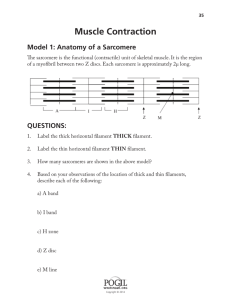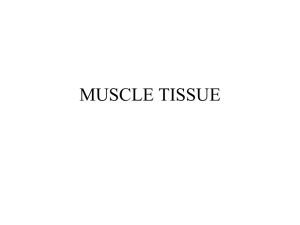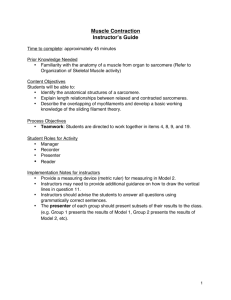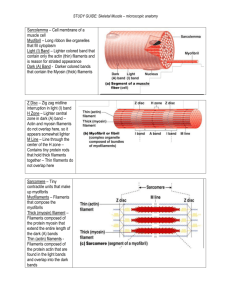File
advertisement
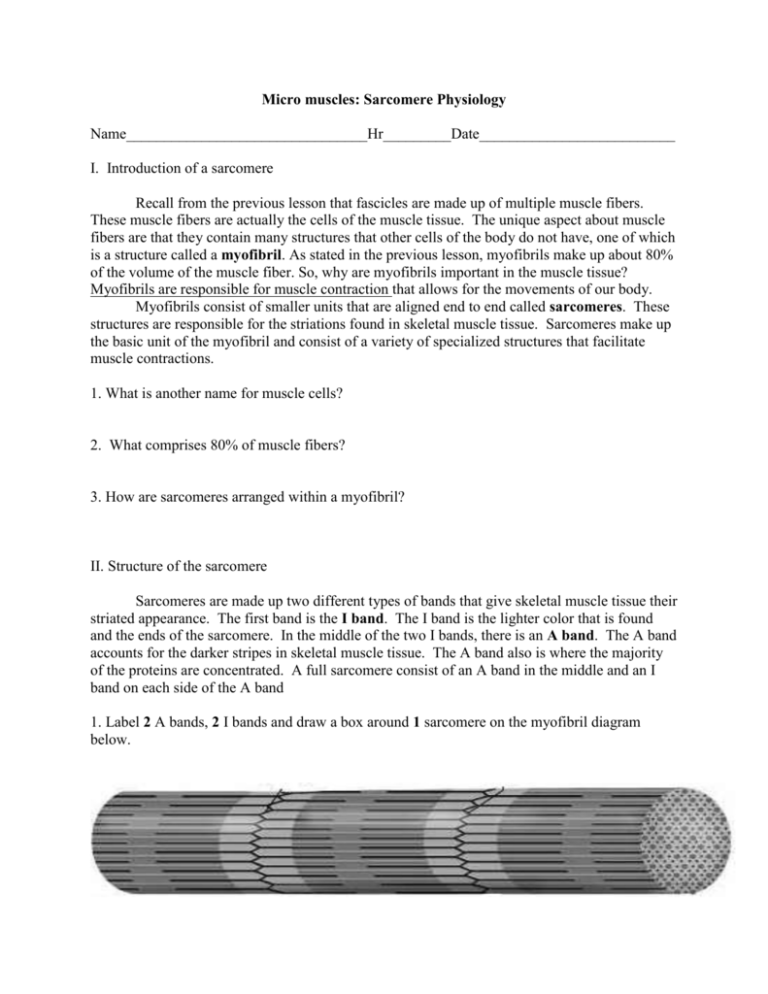
Micro muscles: Sarcomere Physiology Name________________________________Hr_________Date__________________________ I. Introduction of a sarcomere Recall from the previous lesson that fascicles are made up of multiple muscle fibers. These muscle fibers are actually the cells of the muscle tissue. The unique aspect about muscle fibers are that they contain many structures that other cells of the body do not have, one of which is a structure called a myofibril. As stated in the previous lesson, myofibrils make up about 80% of the volume of the muscle fiber. So, why are myofibrils important in the muscle tissue? Myofibrils are responsible for muscle contraction that allows for the movements of our body. Myofibrils consist of smaller units that are aligned end to end called sarcomeres. These structures are responsible for the striations found in skeletal muscle tissue. Sarcomeres make up the basic unit of the myofibril and consist of a variety of specialized structures that facilitate muscle contractions. 1. What is another name for muscle cells? 2. What comprises 80% of muscle fibers? 3. How are sarcomeres arranged within a myofibril? II. Structure of the sarcomere Sarcomeres are made up two different types of bands that give skeletal muscle tissue their striated appearance. The first band is the I band. The I band is the lighter color that is found and the ends of the sarcomere. In the middle of the two I bands, there is an A band. The A band accounts for the darker stripes in skeletal muscle tissue. The A band also is where the majority of the proteins are concentrated. A full sarcomere consist of an A band in the middle and an I band on each side of the A band 1. Label 2 A bands, 2 I bands and draw a box around 1 sarcomere on the myofibril diagram below. Each band of the sarcomere contains smaller sections that can be identified easily. In the middle of the I band lies the Z disk. The Z disk separates two adjacent sarcomeres’ I bands. Remember that each sarcomere has I bands on each of its ends, so the Z disk is the region that separates to two I bands from each other. In the middle of the A band, the H zone can be found. The H zone is only visible when muscle fibers relax due to a decreased number of sliding filaments in the region. We will discuss this later in the material. Finally, the last region that makes up the sarcomere is the M line. The M line bisects the middle of the H zone around the circumference of the sarcomere. 2. Label 2 Z disks, 1 M line, and one H zone that reside in a single sarcomere on the myofibril diagram below Inside the sarcomere there arises a noticeable pattern of arrangement created by myofilaments. Myofilaments make up the structures that orient themselves along the long axis of the myofibril and are comprised of two different types of filaments: thick filaments and thin filaments. Thick filaments are made of myosin bundles, a motor protein that we will discuss in depth later. Thick filaments are held in place in the sarcomere by an elastic protein called titin which connects to the Z disk on the other end. Thin filaments are comprised of actin, a protein that is used for myosin to attach and “walk” on which ultimately causes muscle contraction. These filaments also have two strands of tropomyosin that wrap around the actin filament that block myosin’s ability to bind to it. Another protein that is found in these filaments is troponin, which inhibits tropomyosin and allows myosin from the thick filament to bind to the thin filament. Thin filaments attach to the Z disk at one end span towards the middle of the A band. We will discuss the physiology of movement in the next lesson. 3. What protein makes up thick filaments? 4. What makes up thin filaments? Label 1 actin filament, 1 myosin bundle, and 1 titin protein. III. Sliding filament model In 1954, Hugh Huxley proposed that during muscle contraction, muscle cells do shorten in length. He hypothesized that the filaments that make up the sarcomeres slide past each other during muscle contraction. At a relaxed state, the filaments (thick and thin) have little overlap with one another. During contraction, the thick and thin filaments become more overlapped and this brings the Z disks of the sarcomere closer together. This theory is known as The sliding filament theory. 1. Construct a sarcomere out of pipe cleaners and assemble it on a white board. Label the Z disk, H Zone, M line, thick and thin filaments. Make sure that you can move the model in a way that can demonstrate the sliding filament theory. Once the model is completed have the teacher check your model __________________ IV. Accessory Structures of sarcomeres Aside from the major functional structures of the myofilamants, other structures are needed to aid and support the functions and maintenance of muscle fibers. One of which is the Sarcoplasmic reticulum (SR). The sarcoplasmic reticulum is a more developed endoplasmic reticulum (Remember from Bio I that the smooth endoplasmic reticulum is responsible for lipid production and detoxification functions). The SR surrounds each myofibril like a sleeve of a loosely crocheted sweater. The SR creates a system of hollow tubules that allow the transport and control of calcium ions to the myofibrils. Most of them are oriented along the long axis of the myofibril, but some orient themselves perpendicular to the long axis of the myofibril. This portion of the SR is called the terminal cisternae and is mostly found I – A band junctions. T tubules are the second type of accessory structure that aid in sarcomere function. These structures are found at the I- A band junction and serve as an entry point for electrical impulses from the nerves to reach the inner layers of the muscle fiber’s myofibrils. The T tubule is an extension of the muscle fiber’s sarcolemma (cell membrane) which allows outside signals to penetrate into the interior of the muscle fiber. Where T tubules meet terminal cisternae it is called a Triad. This is because the T tubule interacts with terminal cisternae on either side. This is primarily where electrical impulses trigger calcium ion release from the SR into the myofibril. Using page 289 of the new book, label the components of the muscle fiber. V. Review: Answer book questions 1-4 in the new book on page 289. 1. 2. 3. 4.


